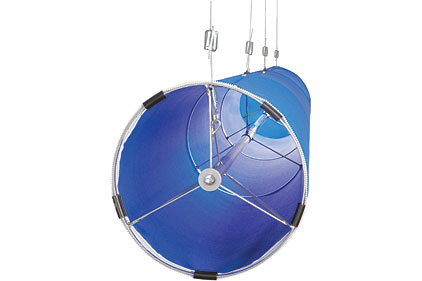
|
| Fabric duct manufacturers have recently introduced tensioning devices to improve the installed appearance of the product. Pictured above is the Skelecore FTS tensioning system from DuctSox. |
According to insulated duct industry sources, around 50 percent of new homes were constructed using some form of insulated duct in 2000 and that percentage grew to 67 percent in 2011. Additionally, flexible duct annual sales are estimated to be in the $400-$500 million range, even in a severely depressed housing market, according to Ardee Toppe, president of Quietflex.
Toppe said, “No HVAC dealer wants to be tagged for installing a high-efficiency system that doesn’t deliver as promised due to a faulty air distribution system. Energy and performance audits are putting more emphasis on the vital role that the air distribution system performs in a central heating and cooling system.”
Insulation Solutions
The current push for increased energy efficiency and energy audits has led to a greater emphasis on presenting homeowners with a whole-home solution. Additionally, more and more building codes and standards are focusing on the existing air distribution system in the home as the cause for energy loss and are recommending the use of properly sealed insulated duct systems as the solution.
The spotlight has definitely moved from the efficiency of heating and air conditioning equipment to the makeup, design, and performance of the duct system — and this is evident in the reports being released by government agencies and industry associations.
According to a Department of Energy (DOE) report, “Most duct systems lose 25-40 percent of the energy.” Similarly, the Environmental Protection Agency (EPA) has stated that “as much as 30 percent of energy is lost due to duct leakage.”
A publication from the North American Insulation Manufacturers Association (NAIMA) titled “A Comparison of Air Duct Systems Energy Savings and Acoustical Performance” claims, “As much as 30 percent of conditioned air can be lost at the unsealed joints [of metal ducts]. Heat is lost by radiating through the uninsulated metal.”
This added attention has made insulated duct products a viable alternative to sheet metal systems. Fibrous glass insulated flexible ducts help to deliver conditioned air at or close to design temperatures while offering the advantage of light weight and the flexibility to be routed through spaces with obstructions such as attics.
NAIMA has also published “A Guide to Insulated HVAC Duct Systems,” which claims that fibrous glass duct board systems offer thermal and acoustical insulation “plus essentially airtight performance … with one product installed by a single contractor.” More specifically, NAIMA noted, “Closures made with UL 181A-listed pressure-sensitive tape, heat-activated tape, or glass fabric and mastic, save energy by virtually eliminating air leakage.”
Mold Issues
The HVAC industry is no stranger to the issue of mold, and insulated duct manufacturers are quick to point to studies that show fiberglass is resistant to mold. In fact, NAIMA released a report that stated, “Stringent testing in accordance with the American Society of Testing Materials (ASTM) confirms that fiberglass insulation meets the requirements for mold resistance.”
To provide added assurance to contractors and homeowners, however, industry manufacturers offer products like the Quietflex AMGFlex™, which is constructed of formaldehyde free insulation coupled with an antimicrobial core.
Installation Practices
In addition to energy efficiency, duct board offers some attractive advantages because the cost of entry is very low, the tools are simple to use, and the equipment required to fabricate duct board does not represent a large investment.
Additionally, Toppe claimed that flexible duct offers the advantage of installation speed. “Flexible duct is easy to transport to the job site,” he noted, adding that flexible duct offers fast, efficient, and easy installation procedures. “Sealing joints in a flexible duct air distribution system is easy, too.”
Training and installation support for HVAC contractors is offered by trade associations like NAIMA and the Air Diffusion Council. For example, the Air Diffusion Council offers a new online training program “Proper Flexible Duct Installation Practices,” which is approved by the major building codes, at www.airdistributioncouncil.org.
As customers continue to gain more awareness of energy efficiency — and where it is lacking — in their homes, contractors should consider providing them with alternatives to the traditional sheet metal duct systems.
Sidebar: Fabric Duct Makes Inroads
Fabric duct is another alternative duct system that has gained a significant toehold in the commercial market. It is especially suited for gymnasiums, indoor pools, and industrial applications that have large spaces requiring a large amount of airflow.
Even in a down market, fabric products represent over $30 million annually, according to Nick Kaufman, director of manufacturing and engineering for DuctSox Corp. Another sign that the fabric market is here to stay is its inclusion in the new 2012 ASHRAE Duct Design Guides.
The major performance benefit of fabric duct is linear dispersion, or the ability to provide air vents along the entire building or space to eliminate hot or cold spots.
Kaufman pointed to a study conducted by the Mechanical Engineering Department at Iowa State University titled “Thermal Comparison Between Ceiling Diffusers and Fabric Ductwork Diffusers for Green Buildings.” According to the study, fabric duct heats rooms fast and uniformly to satisfy temperature set points, which results in reduced mechanical equipment runtime, thus saving energy in the process. To view the entire study, go to www3.me.iastate.edu/bglab/.
Manufacturers have significantly improved the appearance of fabric duct with the introduction of tensioning devices like the Skelecore FTS tensioning system from DuctSox, which prevents a “deflated look” and enables building owners to run VAV systems all the way down to zero to conserve energy when needed.
Publication date: 10/15/2012










